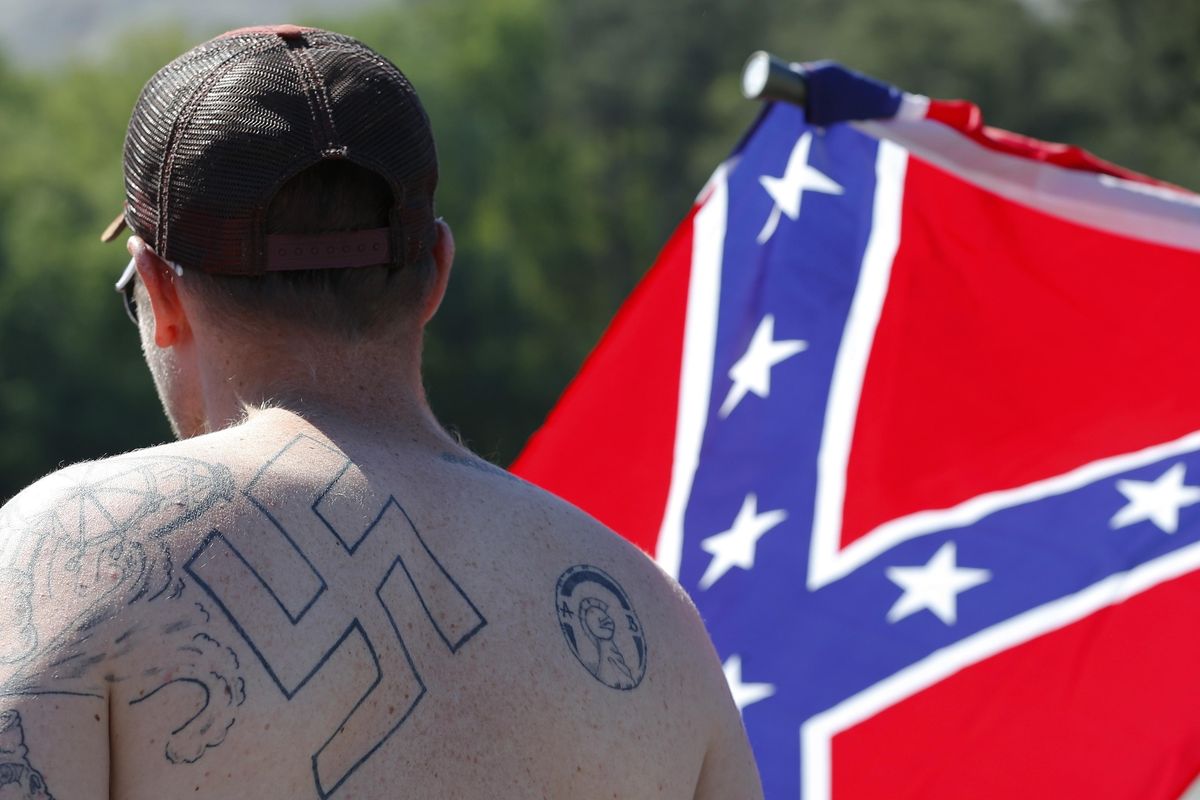White-power groups banding together, but for how long?
Members of the Ku Klux Klan participate in cross and swastika burnings after a "white pride" rally April 23, 2016, in rural Paulding County near Cedar Town, Ga. (Mike Stewart / AP)
BIRMINGHAM, Ala.– White extremists, almost by nature, are seldom good at working together.
Creating consensus among white nationalists, neo-Nazis, Ku Klux Klansmen and the like is akin to herding rattlesnakes, given the caustic personalities often involved. Members typically get mad at each other and split, sometimes within days, resulting in the near-constant creation of new groups and a churning of both leaders and followers.
That’s why it’s something of a feat that an alliance of white-power groups born in a KKK bar in Georgia is marking its first birthday this month. Composed of multiple extremist groups, the Nationalist Front had its anniversary Saturday.
Similarly, six Klan organizations from around the country announced a consolidation last month.
The common goal, as these alliances see it, is protecting the white race at a time when the Census Bureau projects whites will be a minority within three decades.
Watchdog groups that track hate organizations aren’t impressed. They say the Nationalist Front now lists 11 member groups, about half the number it had when it was formed.
“These things never last,” said Heidi Beirich, director of the hate-monitoring Intelligence Project at the Southern Poverty Law Center.
Beirich said that while white supremacists have been emboldened by President Donald Trump’s election, such groups have been trying on and off for decades to merge, generally to appear larger than they really are.
But leaders say there’s a difference this time: A spokesman for the Nationalist Front, Matthew Heimbach, said U.S. nationalists are trying to follow the example of far-right European groups that have learned to work together rather than bicker over ideology, theology and organizational structure.
U.S. nationalist groups have cooperated on projects such as video presentations and propaganda strategies over the last year, Heimbach said, and they worked together to support white nationalist Richard Spencer when he spoke at Auburn University earlier this month.
Originally called the Aryan National Alliance, the Nationalist Front renamed itself and dropped its use of the swastika in an attempt to broaden its appeal.
Some robe-wearing KKK members who were initially part of the Nationalist Front dropped out, and some Klan groups are now consolidating to build membership and power.
The American Alliance of Klans formed during a meeting in rural Florida in March. More Klan groups have joined since, leaders say.
Tom Larson of Delaware, imperial wizard of the East Coast Knights of the KKK, a part of the new alliance, said: “We want to see people stand up and make this country great again, like Trump is saying. We’re tired of seeing white people lose everything.”
None of these groups will provide membership numbers, but it’s safe to say none is huge. About 100 people have registered to attend a Nationalist Front gathering this weekend in Pikeville, Kentucky, Heimbach said.
Photos from the meeting where the Klan alliance was formed showed about two dozen people in KKK robes and black uniforms giving the Nazi salute, but organizers said that was only leaders and does not represent total membership.
Both the Nationalist Front and the Alliance of Klans are but shadow of the United Klans of America, an Alabama-based group that claimed membership in the thousands in the 1960s and was blamed for the 1963 Birmingham church bombing that killed four black girls. It was disbanded in 1987 after the Klan murder of a black man resulted in criminal convictions and a lawsuit that bankrupted the group.
The SPLC’s Beirich said she is less worried about new supremacist alliances than free-standing extremist entities like the Daily Stormer, which she describes as an anti-Semitic, misogynistic, racist website that entered the real world last year by forming “book clubs” that hold local meetings.
Beirich said a single hate-based website can reach millions.

